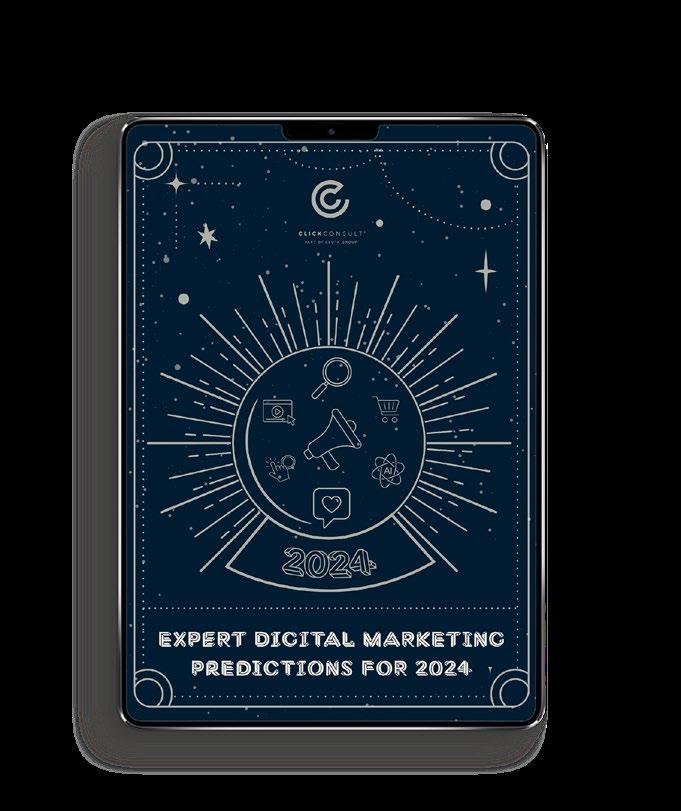Navigating the digital labyrinth, conquering leading search trends, & myth busting in the modern era.
SEARCH MARKETING MAGAZINE


TRENDS
NEWS
PREDICTIONS

Navigating the digital labyrinth, conquering leading search trends, & myth busting in the modern era.
SEARCH MARKETING MAGAZINE


TRENDS
NEWS
PREDICTIONS




Hello, and a warm welcome to the eagerly awaited 13th issue of Benchmark, Click Consult’s renowned search and digital marketing publication.
In this edition, our talented contributors have seamlessly infused their expert knowledge on digital and search marketing trends with the fantastical world of Greek Mythology.
As we delve into the digital labyrinth of navigating the leading search trends, our literary heroes deliver cutting-edge insights, and uncover the truths hidden beneath the surface of common misconceptions about digital marketing. From recovering your website after search engine updates, to exploring the changes to the organic search landscape in the last decade, our expert contributors draw parallels between ancient legends and modern marketing challenges, illuminating the path to success.
I take immense pride in the dedication and expertise of our search marketing professionals that continuously propel us to maintain leadership in the digital and search marketing landscape.
As always, Benchmark is filled with thought-provoking content and actionable advice. I trust that you’ll find this edition both enlightening and inspiring, and that you’ll gain valuable insights to steer your digital marketing endeavours toward resounding success.
Thank you for embarking on this mythic journey with us.
 Julie Sowa, Managing Director
Julie Sowa, Managing Director
CONTENT
Sian Badich
Sophie Deakin
Becky Gardiner
Nicola Glancey
Lara Harding
Owen Parry
Alan Reeves
DESIGN
Lisa Anne Mittal
PUBLISHED BY Click Consult Ltd
ADDRESS
Willow House Oaklands Office Park Hooton
Cheshire CH66 7NZ
PHONE 0845 307 4487
WEBSITE www.click.co.uk
SOCIALS
If you like what you read, shout about it and tag us on your social platforms: linkedin.com/click-consult @ClickConsultLtd facebook.com/ClickConsult @clickconsult
6
KEY INDUSTRY UPDATES
The latest updates in search and digital marketing
12
CONQUERING THE DIGITAL REALM AFTER THE ‘COOKIEPOCALYPSE’: HOW TO NAVIGATE THE THIRD-PARTY COOKIE PHASE-OUT
Strategies for marketers to thrive amidst the third-party cookie phase-out
16
THE FALLACY OF IPHIGENIA’S SACRIFICE: RECOVERING FROM THE HELPFUL CONTENT UPDATE
Using parallels from famous Greek Myths to provide insights into recovering from algorithm updates and crafting helpful content



20
DOMINATING SEARCH RANKINGS WITH WITH USER FOCUSED CONTENT
How Click Consult used User Focused Content to skyrocket Ultra Chloraseptic’s Organic Search rankings
22
THE LITERARY MUSES OF THE DIGITAL AGE: WHICH INDUSTRIES BENEFIT MOST FROM BLOGGER COLLABORATIONS AND HOW TO MAKE THE MOST OF THE OPPORTUNITIES
Maximising blogger collaborations for niche industries
25
EXPERT DIGITAL MARKETING PREDICTIONS FOR 2024
Click’s comprehensive guide offers insightful knowledge to prepare strategies for the remainder of the year
26
THE TIME TRAVELLER’S SEO STRATEGY: HOW HAVE SEO STRATEGIES EVOLVED OVER THE LAST 10 YEARS?
Insights from a time-traveller’s conversation on holistic SEO strategies, quality content, and technical excellence
28 THE HERCULEAN JOURNEY FROM MANUAL TO MACHINE: EXPLORING THE PAST, PRESENT, AND FUTURE OF THE PAID MEDIA LANDSCAPE AND HOW IT HAS SHAPED THE PROFESSIONALS BEHIND THE TECH
A comprehensive exploration of the historical, current, and future trends in Paid Media, including the evolution of roles and strategies alongside advancements in technology



31 SPECIALIST SECTORS
Leveraging over two decades of experience in digital and search marketing, we offer tailored strategies for various sectors, addressing unique challenges and objectives
32
HARNESSING THE INFLUENTIAL POWER OF ‘SOCIAL SIRENS’: INFLUENCER MARKETING BEYOND SOCIAL MEDIA
An analysis of influencer strategies beyond Social Media to drive engagement and enhance brand credibility
36
TIKTOK’S OLYMPIAN RISE FROM YOUTH ENTERTAINMENT PLATFORM TO RULING THE SEARCH REALM: HOW HAS A SOCIAL MEDIA PLATFORM BECOME ONE OF GOOGLE’S BIGGEST RIVALS?
Exploring TikTok’s evolution from a Social Media platform for dance trends to a multifaceted digital hub

From the buzz around generative AI to the growing focus on data privacy, new core algorithm updates, and major social media shifts, there’s a lot to unpack. But one thing remains constant: authenticity. Google continues to prioritise high-quality, experiential content, reflecting the broader public desire for trustworthy and genuine interactions throughout their online experience. With that in mind, let’s explore the most important recent developments.
EARLY FEBRUARY 2024: THE CURTAIN CLOSED ON GOOGLE’S WEBSITE CACHE
In a move reflecting the internet’s growing stability, Google discontinued its website cache function in early February 2024. This means you’ll no longer see the option to view an archived snapshot of a web page from Google’s search results. But, what are the implications for Search?
• No more outdated content: While some users relied on cached pages to access sites during outages, the focus now shifts to the most recent version (assuming the site is live). This ensures you encounter the freshest content available.
• Limited access to historical web versions: Those who used cached pages for archival purposes will need to find alternative solutions. Services like the Wayback Machine (archive.org) can help access past versions of webpages.
FEBRUARY 22ND 2024: GOOGLE’S COLLABORATION WITH REDDIT AND IMPLICATIONS FOR SEARCH ALGORITHMS
In a significant development, Reddit and Google have joined forces to streamline content delivery through Reddit’s data API. This collaboration seems to shed light on preferential treatment for prominent content distributors and the potential integration of a website’s content syndication API into Google’s ranking algorithm. This move raises speculation about whether Quora is undergoing a similar process, hinting at possible future implications for content distribution and search engine rankings.
MARCH 5TH 2024: FIRST CORE UPDATE OF 2024!
The first Google core algorithm update of the year launched! And it’s a big one. On 5th March, Google announced the latest update stating:
“The March 2024 core update is more complex than our usual core updates, involving changes to multiple core systems… As this is a complex update, the rollout may take up to a month. It’s likely there will be more fluctuations in rankings than with a regular core update.”
The spam update lasted 2 weeks and has now finished rolling out mid March. The March 2024 core update also saw the “Helpful Content Evaluation” into the core algorithm.
MARCH 5TH 2024: GOOGLE BUSINESS PROFILE
WEBSITE SHUT DOWN
In a move to streamline the online experience for businesses and customers, Google shut down websites created through Google Business Profiles. These were the free, single-page websites automatically generated when you claimed your business listing. Here’s what you need to know:
• Websites are gone: If you previously relied on a Google Business Profile website, visitors trying to access that URL will now encounter a “page not found” error.
• Redirection period: Until June 10th 2024, Google are offering a temporary redirection to your website.

• Business Profiles remain: Thankfully, Google Business Profiles themselves are unaffected. They continue to be a vital tool for managing your online presence, attracting local customers, and improving local SEO.
MARCH 7TH 2024: GOOGLE’S OVERLAPPING UPDATES & CONFUSION
Google’s March core update shook things up! With the March core update, spam policy updates, manual actions, and core web vitals happening simultaneously, businesses have been finding it difficult to understand what is affecting what. Google has stated they do ‘generally try to avoid’ this overlapping, but with the ongoing goal to improve search, the updates have been launched at the same time.
MARCH 12TH 2024: INTERACTION TO NEXT PAINT IS ROLLED OUT
Two years after the successful launch of the Core Web Vitals in early 2020, Google announced they would be launching a new metric known as Interaction to Next Paint (INP). The original core web vitals did not take into account the engagements made on a page after it loads, and therefore INP was introduced to bridge this gap.
INP has officially replaced the previous metric known as First Input Delay (FID).
19TH APRIL 2024: CORE UPDATE FINISHED ROLLING OUT
The first core update of 2024 was a long one, taking almost a month and a half from launch to rollout completion. This core update marked a significant shift in Google’s approach, incorporating changes to multiple core systems and ending the standalone helpful content update. The update aimed to reduce low-quality and unoriginal content in search results, ultimately achieving a 45% reduction instead of the initially expected 40%.
With overlapping updates, including spam updates and changes to core web vitals, pinpointing specific impacts on site performance has become challenging.
MAY 2024:
Google is expanding its AI Overviews feature in Google Search to all US users, with plans to reach over a billion users globally by the end of the year. AI Overviews leverages Google Gemini to provide detailed answers to complex queries, and these snippets are then shown selectively for questions where they add significant value beyond standard search results:
• Google doesn’t plan to separate AI Overview data in their Search console, merging it with traditional search data.

• Despite AI Overviews sometimes providing incorrect information, Google is improving its accuracy over time.
• Ads will continue to appear alongside AI Overviews, with new ad formats being tested.
• Featured snippets will remain a part of search results, coexisting with the new AI Overviews.
From the rise of short-form video ads to the transformative influence of AI on personalised content and automated bidding, the landscape is continually changing for paid ads. AI and privacy take the spotlight in this quarter’s narrative, however. Marketers find themselves grappling with the integration of AI into campaign workflows and optimisations, a challenge they must navigate to stay ahead. Additionally, the long-anticipated phase-out of Chrome third-party cookies has commenced, starting with an initial 1% of users in January 2024. As we navigate towards a future of immersive advertising experiences, the momentum in paid ads shows no signs of slowing down.
JANUARY 2024: GOOGLE SUPERCHARGES PERFORMANCE MAX WITH AI-GENERATED ADS
Google’s Performance Max (Pmax) campaigns had a major upgrade with the power of AI. Pmax can now generate text, headlines, and even images based on campaign goals.
This means faster campaign setup, more creative testing options, and potentially even better ad performance. Plus, Google’s “Gemini” AI model is behind the scenes, analysing data to suggest the best creative combinations.
RISE OF SHORT-FORM VIDEO ADS
Short-form video ads, clocking in at mere seconds, are capturing attention. This rise transcends mere trends; it reflects a deeper shift in how we consume content – on-thego, bite-sized, and highly visual.
Beyond engagement, data speaks volumes. Studies reveal significantly higher click-through rates compared to traditional ads. Democratisation further fuels this revolution. Platforms like TikTok empower even small businesses to create compelling content, levelling the playing field and fostering innovation.
Looking ahead, the future promises even more immersive experiences. Interactive elements, seamlessly integrated shoppable features, and AI-powered personalisation will blur the lines between ads and engaging narratives. It’s a shift from mere promotion to curated experiences, tailored to individual preferences and desires.
JANUARY 4TH 2024: GOOGLE BEGINS DEPRECIATION OF THIRD-PARTY COOKIES
Google announced their decision to depreciate third-party cookies back in July 2022, and that rollout officially began in early January this year. This decision follows in the footsteps of other major search engines, such as Firefox and Safari who have previously put measures in place to restrict tracking from third-party cookies.
Chrome has over 66% of the browser market share worldwide, meaning that this change is going to have a significant impact
on both users and marketers when compared to earlier browsers having made similar changes.
The cookie depreciation is part of a wider initiative related to Google’s Privacy Sandbox, which both strengthens privacy, but also gives businesses the tools to facilitate growth.
Google states that they are on track to move forward with the planned timeline, and will work to the schedule of removing third-party cookies for all Chrome users by the end of 2024. They are confident that the current timeline allows businesses ample time to:
• Trial operation without third-party cookies
• Provide feedback during testing phases
• Make preparations for the full depreciation rollout
JANUARY 23RD 2024: GOOGLE ROLLS OUT CONVERSATIONAL AI IN SEARCH ADS

Google is launching a conversational experience in Google Ads powered by its Gemini AI model, aiming to streamline the ad creation process. In early testing, advertisers have reported:
• The ability to build higher-quality search campaigns with less effort.
• Increased Ad Strength scores that measures relevance, quality, and diversity of ad copy.
The conversational experience allows advertisers to generate relevant ad content, including creative and keywords, from a website URL. Beta access is now available to Englishlanguage advertisers in the U.S. and U.K., with a global rollout in the coming weeks.
FEBRUARY 2024: YOUTUBE ADS ON GOOGLE TV
The surging popularity of Connected TV (CTV) is creating a prime advertising opportunity. Google TV, with its 220 million monthly active devices and significant year-over-year growth, reflects this trend. Recognising this shift, Google recently updated its ad platform to offer more granular control.
Advertisers can now specifically target Google TV within their YouTube campaigns, allowing them to capitalise on CTV’s projected ad spend increase of $33 billion in 2024. This update empowers businesses to precisely align their video advertising strategy with the evolving media landscape.
Gone are the days of all-or-nothing with Google TV ads. Now, you have the freedom to choose! By simply adjusting your line item settings, you can decide whether your ads appear on Google TV independently of other YouTube partner channels. This means you can leverage the growing Google TV audience (220 million strong!) as a separate targeting option within DV360.
When it comes to social news and feature updates, 2024 has already delivered. Whether it’s the search for authenticity, the rise of “everything apps,” or the evolving search landscape, one thing’s certain: social is showing no signs of slowing down this year!
JANUARY 24TH 2024: IS SOCIAL MEDIA BECOMING THE NEW WAY TO SEARCH IN 2024?
There is a growing trend among Gen Zs and millennials to prefer social media platforms over traditional search engines. Approximately a quarter of 18 to 54 year olds now favour social media for searching, with Facebook and TikTok ranking closely behind Google in user preferences. Marketers are starting to recognise the significance of “social SEO” strategies, aligning with social media experts to create effective plans for reaching this audience.
Despite the increasing popularity of social search, traditional search engines remain dominant for now, but with the evolving preferences of younger generations, could there be a potential shift in the future?
FEBRUARY 8TH 2024: TIKTOK IS PUSHING A NEW SEARCH SHORTCUT
TikTok is promoting a new search shortcut, encouraging users to conveniently add it to their device home screens, as part of its ongoing efforts to boost search activity on the platform.
In China, the local version of TikTok, known as “Douyin,” offers users the ability to search for local businesses, restaurants, and entertainment. It has also introduced generative AI search, enhancing user discovery inside and outside the app, including the capability to order food directly. Seemingly, TikTok is aiming to follow this trajectory, intending to broaden its utility beyond entertainment and establish itself as an essential tool for its extensive user base, exceeding a billion users.
TUESDAY 12TH MARCH 2024: IS TIKTOK DEVELOPING A RIVAL IG APP?
TikTok is said to be creating a photo-centric app to rival Instagram, as indicated by recent findings in the app’s code. The references to “TikTok Photos” suggest that users will be prompted to share still images in the new app, aiming to connect with like-minded individuals who appreciate photo posts.
MARCH 13TH 2024: POTENTIAL TIKTOK BAN FOR US
It’s not looking good for TikTok in the USA. The U.S. House of Representatives has passed a bill mandating ByteDance, the parent company of TikTok, to sell the platform within six months, or face a complete ban in the United States. Failure to comply would result in the loss of TikTok’s 150 million American users. This development is of significant concern to advertisers, particularly those targeting Generation Z, as TikTok is a preferred platform for this demographic. Its potential ban would heavily impact advertisers reliant on TikTok to reach this audience, making it a crucial channel for their marketing efforts.
So, how has this ban come about? Well, due to ByteDance being based in China, it comes under official Chinese cybersecurity laws. Meaning all of the data collected from US
TikTok users could be passed over to the Chinese Communist Party, thus posing a risk on national security.
THURSDAY 14TH MARCH: LINKEDIN SPONSORING ORGANIC POSTS
LinkedIn has a new feature which allows businesses to promote organic users posts, rather than just verified employees. This is an important step for brands, as promoting content about your business that has come from external sources improves credibility and trust which could lead to more conversions.
LONG-FORM VIDEO COMEBACK!
While bite-sized entertainment remains a powerful tool, a hunger for deeper engagement is emerging. Audiences are increasingly seeking content that allows them to delve into narratives, explore complex topics, and develop a sense of connection with the material they consume.
Even platforms synonymous with short videos, like TikTok, are embracing long-form video formats. Extended upload times and a focus on horizontal filming signal a move towards more polished, documentary-style content. Instagram is following suit, experimenting with Reels that extend beyond the traditional minute limitation.





Reality: The industry is adapting to alternative solutions, such as firstparty data, contextual targeting, and privacy-focused technologies, ensuring that personalised experiences can still be delivered without compromising user privacy

Cast your mind back to February 2020 - when Google initially announced the phase out of third-party cookies on Chrome. Experts coined it ‘cookiepocalypse’, unleashing two years of marketer turmoil, leaving us all scratching our heads.
Yet, with Google persistently pushing back implementation and the emergence of trends like Gen AI, the looming cookie countdown seemed to lose its grip on our collective consciousness. Fast forward to January 2024, and the initial cookie depreciation for 1% of Chrome users served as a wake-up call.
Adjust your warriors helms, this isn’t the end – just like FireFox and Safari, we’re hurtling towards a 100% phase-out by yearend for Chrome. It’s time to arm ourselves for a cookieless future.
I know what you’re thinking, it’s a delectable treat that captivates the senses… Alas, these cookies aren’t for savouring. They’re small pieces of data stored on a user’s device by a web browser and primarily serve for identification. You’ve likely experienced the magic of auto-filled login details and noticed the new car you searched for trailing your online journey.
Just like with real life cookies, there are different flavours to choose from. The two main types are:
• First-party cookies: These are set by the website being visited, and they are often used to remember user preferences, login information, and other settings.
• Third- party cookies: These are set by domains other than the one the user is visiting. They are commonly used for tracking and collecting data across websites for advertising and analytics purposes. And your data can be shared more widely than you may like.
It doesn’t take Athena’s wisdom to figure out which of the two sounds a little more foreboding.
WHY THE MOVE TO ELIMINATE THIRD-PARTY COOKIES?
Over the years, third-party cookies have found themselves in the hot seat, facing relentless scrutiny for their involvement in data collection, profiling, and real-time bidding – all done with a nonchalant disregard for user consent.
The big concerns revolve around:
• Privacy: Tracking user behaviour without them being aware
• Ad fraud: Cookies, particularly through tactics like cookie stuffing, contribute to ad fraud, allowing malicious actors to generate fake sales.
• Security: Cookies pose substantial security threats, from Cross-Site Request Forgery attacks to CrossSite Scripting and more. These vulnerabilities not only jeopardise users but also the security of the visited websites.
68% of US consumers are concerned about the amount of data businesses collectAdobe, 2023
This invasive strategy not only triggers the privacy alarm bells but also hands advertisers the golden ticket to users’ personal data, allowing them to concoct hyper-targeted campaigns that dive into users’ personal micro-details. A genuine “nono” in the court of public opinion.
“Users
are demanding greater privacyincluding transparency, choice and control over how their data is used - and it’s clear the web ecosystem needs to evolve to meet these increasing demands” - Google
SHOULD WE BE SCARED?
Although third party cookies were still being used for around three quarters of programmatic ad buys across all industries (London Evening Standard, 2024) as of the third quarter of 2023, whether businesses have anything to be scared about hinges on how much their marketing strategy relies on thirdparty data for advertising and analytics.
If you think about digital marketers, advertisers, and adtech services, these companies are deeply entrenched in the world of targeted ads and user tracking, with some still heavily reliant on these cookies for their 2024 strategies. For them, the fading out of traditional third-party cookies will more than likely mean having to navigate uncharted waters, meaning a major (and quick) change of tactics on how they can retarget consumers.
On the other end of the spectrum, businesses such as eCommerce platforms, publishers, and companies who lead the charge in first-party data collection and nurturing customer relationships will be less affected and much more ready for adaptation to cookie regulatory changes.
SURVIVING A COOKIELESS FUTURE
But, the burning question is: Can we thrive in a future without cookies? The answer is simple - absolutely. In fact, navigating a world devoid of these cookies opens up alternative avenues for businesses and marketers to still effectively target and personalise campaigns to users, all while prioritising privacy.
Here are the top alternatives for third-party cookies:
First-party data
First off, deep breaths everyone, we’re not saying goodbye to all cookies. The good news is that first-party cookies are not only sticking around but are deemed ‘vital’ by Google.
Without third-party cookies, businesses can still target users using first-party cookie data by leveraging the information collected directly from their interactions on the specific website. By merging insights from various sources like purchases and user-provided details, you get a thorough understanding of their interests.
Instead of relying on third-party cookies that track users across multiple websites, first-party cookie data enables targeted approaches within the context of a single website, maintaining user privacy and complying with evolving privacy regulations.
Another important aspect of gathering first-party data is ‘hashed emails’. If you’re unaware of this term, it’s a technique for keeping user info incognito while maintaining the ability to recognise them across the vast web. As we live in an emailcentric world, where we login to most platforms, users can still be tracked across the web via social media, browsers, mobile devices and even TVs and tablets.
Much like first-party cookies, hashed emails offer superior user security, surpassing the privacy concerns linked with
third-party cookies. This makes them an excellent alternative for cookie-based marketing.
Key advantages of first-party cookies over third-party cookies:
• Non-Anonymity: Unlike third-party data, first-party data is not anonymous, providing a deeper understanding of individual user identities.
• Permission-based marketing: First-party data operates under a consent framework, ensuring users willingly share their information. This permission-based approach enhances trust and compliance.
Contextual advertising involves strategically placing ads on a webpage, aligning with its content. For instance, if your niche is eco-friendly home products, you could display your ads within an article discussing sustainable living practices. This approach entails segmenting and targeting ad space based on website topics, keywords, or related parameters.
Although contextual advertising may lack the precision of behavioural targeting, it boasts a unique advantage – it doesn’t depend on third-party cookies.
Google’s Privacy Sandbox is a collective effort within the tech industry to strike a balance between personalised advertising and safeguarding user data.
Since 2020, Google has been actively developing a strategy to eliminate the reliance on cookies in Chrome, incorporating it into the broader Privacy Sandbox initiative. Now, you might be wondering, how does this benefit advertisers striving for effective, yet compliant retargeting campaigns? The core concept involves providing advertisers with anonymised user browsing data through Google-provided APIs, enabling them to conduct advertising activities in a manner that prioritises user privacy, whilst still targeting the right audience. The “Topics API,” introduced in July for developer testing, was made accessible for Chrome users to explore in September 2023.
In a nutshell, Privacy Sandbox means advertisers can still hit their target audience effectively, thanks to anonymised user browsing data provided through Google’s APIs. It’s all about striking that balance between privacy and precision, ensuring campaigns stay compliant while reaching the right people.
As we march towards a cookieless future, the time is ripe for website owners, marketers, and businesses to prepare for the impending changes.
Amidst this transition, one strategy remains clear: seize every opportunity to gather first-party consented data cookies. Embracing first-party data strategies is paramount for maintaining targeted ads in the future.
While the phase-out of third-party cookies may seem daunting, it is not the end of personalised advertising. Rather, it presents an opportunity for businesses and marketers to innovate, exploring alternative tracking approaches to navigate advertising in an ever-evolving online world.




Myth: Amending your site after a Helpful Content Update requires too much effort to have a worthwhile effect
Reality: Google’s algorithms and regulations are constantly changing, and updating your website content to reflect this can help you flourish


If you’re familiar with the story of the fall of Troy, you may remember the fate of Iphigenia, daughter of Agamemnon. Agamemnon was the leader of the Greek armies who had come to besiege Troy, and he’d ordered these armies to come together at Aulis, a rocky outcrop where there was plenty of room for the fleet to gather.
While they waited for the rest of the armies to reach Aulis, the early arrivals entertained themselves with song and dance and, most importantly, hunts. It was on one of these hunts that Agamemnon himself rode out and killed a fine stag which, unbeknownst to him, just so happened to be sacred to the goddess Artemis. Enraged, she becalmed the fleet at Aulis so they couldn’t sail on to Troy.
The goddess issued an ultimatum to Agamemnon via his prophet, Calchas. If he wished the winds to return so he and his armies could lay siege to Troy, he must sacrifice his only daughter, Iphigenia. With little choice, Agamemnon did so. In some stories, Iphigenia dies as you’d expect, and in others she is saved by the goddess and spirited away to another town - but in all of the stories, the sacrifice of Iphigenia appeases Artemis and allows the winds to return.
Like many Greek tragedies, the story of Iphigenia has a hidden lesson that we can learn from, and apply to our modern day lives. So what lesson can be extracted from this? And more importantly, what parallels can be drawn from Greek tragedies that can help us enhance our digital marketing, more specifically organic search (SEO) efforts?
The kind of straightforward ultimatum in Iphigenia’s story may sound appealing - once you get away from the idea of human sacrifice, of course - but unfortunately, it’s one myth of Greek legend that doesn’t translate well to SEO.
In reality, Google can be harder to appease than Artemis - but not if you’re willing to put in the work.

So, what can you do to help your site recover after a helpful content update? Well, there are lots of things that can affect the E-E-A-T of your website, helping raters to decide whether your content is helpful or not. Things like authorship, social profile links, and accreditations can be useful - but the biggest impact is likely to come from the content itself.
Let’s take a look at the most common different forms of unhelpful content and how you can rectify them - with a little help from Greek mythology, of course.
First, we begin with the stories of Echo and Narcissus, a pair of characters who are rarely separated in the myths for reasons you’ll come to see.
Echo was a mountain nymph who had many sisters and cousins, all of whom were very beautiful. They frequently attracted the attention of Zeus, king of the gods, who was well known for his promiscuity. Because of this, his wife, Hera, was suspicious whenever he would go off alone. On this occasion, she followed him heading down to a mountain, but instead of finding her husband, she found Echo.




Well aware that Zeus was nearby with one of her sisters, Echo distracted Hera; in some stories, she lied outright when asked where Zeus was, while in others, she merely gossipped and chit chatted until the goddess grew bored and left. Either way, when Hera discovered this betrayal, she cursed Echo so that she could only ever repeat what was spoken to her, never able to say anything for herself.
Occurring in parallel to this is the story of Narcissus, a young man famed for his beauty. This caused him to become incredibly vain and conceited - a trait which earned him a curse from the goddess of vengeance, Nemesis. The next time he saw his reflection, he would immediately fall in love with it.
And so he did, during a hunt on the very mountain where the newly-cursed Echo lived. When she met him, she adored him for his beauty, but she couldn’t say a word of her own to him, and he could love nothing and no one except himself.
These paired stories might seem a world away from digital marketing, but they succinctly display four types of unhelpful content. These are:
• Factual inaccuracies - represented by Echo lying to Hera
• Irrelevant fluff - represented by the alternate version where she distracts the goddess with meaningless chat
• Content that adds no value to what’s already available - represented by Echo’s curse
• Content that favours self-promotion over helping the reader - represented by Narcissus’s vanity and eventual fate
Helpful content aims first and foremost to educate or assist the reader in a way that is relevant to your brand. If any of the above characteristics sound familiar, you may need to audit your content to make sure it’s all accurate, relevant and useful to the reader. Then check that you’ve included additional insights or information to help your content stand out amongst the rest.
2. THE COMEUPPANCE OF AUTOLYCUS
Our next type of unhelpful content is brought to light in the myth of Autolycus, a cattle herder and son of the god Hermes. As well as being the messenger of the gods, Hermes was known for being something of a trickster, and his son Autolycus inherited his flair for thievery. He lived near King Sisyphus - the one who ended up pushing a boulder up a hill for all eternity in the afterlife.
When he was alive, King Sisyphus was very rich and had a great many strong, healthy cattle. Autolycus one day decided to steal these cattle, just a few at a time so as not to arouse suspicion. But Sisyphus was suspicious when he discovered his herd was becoming smaller - he believed Autolycus was the thief, but he couldn’t prove it.
Or could he? In the end, Sisyphus had his cattle marked on their hooves - somewhere Autolycus wouldn’t think to look. Then, when he demanded to inspect Autolycus’s cattle, he found they bore the mark of his own herd and Autolycus was finally caught.
If it’s not already clear, the kind of unhelpful content shown here is stolen or duplicated content. This applies to duplication within your own website - for example, similar products that have identical descriptions - as well as duplication of other sites.
You might think that so long as you are not copying other people’s work, you’ll be fine. However, this is an aspect in which SEO diverts from the myth. While King Sisyphus was able to prove that the cattle belonged to him first, Google can’t tell which example of the content is the original. Therefore, all versions of it will suffer.
So, finding out if your content is duplicated is a clear priority. You can use a plagiarism checking tool such as Copyscape to detect any duplicate content on your site - and if you find any, you should rewrite that content to be more unique and add greater value for the reader.
Many of us have heard the tale of Icarus flying too close to the sun as a metaphor for pride, but were you aware that it’s actually a pretty good metaphor for backing up your content’s claims as well?
In the myth, Icarus and Daedalus attempted to escape captivity by flying across the sea using wings made of feathers, a wire frame and wax to bind the two together. Daedalus, who had designed the wings, warned Icarus not to fly too close to the sun because the heat would melt the wax and cause the wings to fall apart. What’s less well known is that he also warned Icarus not to fly too close to the sea either, because if the feathers got wet then the wings would be too heavy to keep him in the air.
Icarus’s pride and Daedalus’s warnings can be very useful reminders for content writers everywhere, but particularly for those writing on Your Money or Your Life (YMYL) topics. It’s one thing to be proud of your company’s expertise, but backing up your claims with relevant, reliable sources is a great way to show that you know what you’re talking aboutboth to Google and to interested readers.
But just as Icarus should have remained between two extremes, so do content writers. On the one hand, making sweeping claims that can’t be backed up with evidence is clearly a bad choice. On the other hand, it’s also unhelpful to only cover topics at a very shallow level.
In order to provide the most benefit to your readers, you should aim to cover topics in depth while remembering to back up important facts that might affect your readers’ health or finances with reliable sources.
The task of editing your content to help your site recover from a helpful content update might seem Herculean, but it’s well worth the effort. If you leave unhelpful content in place, your site will continue to suffer in search results, which will likely result in a loss of conversions and revenue. But with hard work and a good eye for detail, you can turn your site back around and return to those golden days of flourishing in search results.
How Click Consult used User Focused Content to skyrocket Ultra Chloraseptic’s Organic Search rankings
A subsidiary of Prestige Brands, Ultra Chloraseptic have a range of throat sprays that provide fast acting relief from sore throats. Through their expertise and innovation Ultra Chloraseptic have a lot to be proud of in their pocket-sized sprays; with a swivel head design for easy application, and over 100 sprays in each conveniently sized bottle, the spray works directly where it hurts, without numbing your mouth.
Suitable for ages 6 and above (with adult supervision), Ultra Chloraseptic is the ideal throat spray for the entire family.
In such a saturated market Ultra Chloraseptic approached Click Consult with the objective of increasing organic search and visibility for a number of key terms relevant to the throat medicine market.
After a comprehensive analysis of their keyword strategy, Click suggested targeting long tail keywords with the goal of attaining a wider reach whilst also competing with fewer brands.

Click found several long tail keywords and phrases that had a high search volume, but with low competition. We proposed a plan to write a variety of user-focused content pieces that provided direct responses for the long tail search queries with the goal of obtaining a high rank on the SERPs for these blogs.
Moving forward with the proposed strategy, Click wrote a number of articles that provided answers for queries such as:
• What is Quinsy?
• Can smoking cause a sore throat?
• Why choose a throat spray?
• Is lemon good for a sore throat?

As a result of creating these user focused content pieces, Ultra Chloraseptic now holds the top rank on Google for 11 of the identified long tail keywords. In addition to the above, Ultra Chloraseptic also holds the top featured snippet position for seven queries relating to the keywords.
Almost 62% of all their organic monthly search traffic comes from the content created with the identified long tail keywords in mind.
• 7 featured snippets on Google
• 188k page views
• 11 number 1 ranking positions on Google
How to use throat spray for a cough 1
Can throat sprays help a cough 1
Can nose hair cause congestion 1 Is quinsy contagious 1
Can you get quinsy if you have no tonsils 1
Can you use throat spray for a cough 1
Does smoking cause a sore throat 1
Can smoking cause a sore throat 1
What is the purpose of sinuses 1
Does weather pressure affect your sinuses 1
Can you get hay fever at any age 1
“We have been working with Click for the past few years where they designed and built brand new websites for a few of our healthcare brands. Since launching, we have seen traffic increase up to 8000% on certain websites and we now rank very highly for keywords on Google. If you are looking to drive more users to your website and increase your SEO rankings I would highly recommend having a chat with Click to see how they can help!”
Neil Kotak, Brand Manager at Prestige BrandsWhy do some industries benefit more from blogger collaborations, and how do you make the most of the opportunities?
Nicola Glancey Content Marketing Executive

Myth: Niche industries such as agriculture and transportation are unlikely to benefit from blogger collaborations due to a lack of blogs on their desired topics
Reality: By embracing innovative strategies and thinking outside the box, niche industries can unlock the full potential of blogger collaborations
Blogging has existed since 1994, with the first-ever known blog, Links.net. At the time of its creation, it was not known as a blog but the personal homepage of its owner, Justin Hall. As this style of writing and knowledge sharing became increasingly popular, the term “Weblog” was coined - and was later shortened further to “Blog” in 1999. This slang term stuck, becoming the industry we know today.
What began as a simple method of journaling has become one of the most influential forms of collaborative advertising…
THE ORIGIN OF ‘BLOGGING’
Blogs originally started out as simple online journals, and began to increase in number following the creation of site hosts such as Open Diary, LiveJournal, and Blogger.
The turn of the millennium saw a surge in blogging and the commercialising of blogging in its earliest form.
As the internet transformed, so did the function of blogs. Bloggers transitioned away from the typical “diary” format and transformed it into something new. They began sharing their work and offering up detailed descriptions of
As blogs transitioned into a more influential platform, marketing-savvy businesses saw a new opportunity for advertising products and services.
WHEN DID BLOGGING BECOME BUSINESS?
Bloggers started to make a profit from their writings in the early 2000s when they began generating advertising revenue through share programs, paid sponsorships, affiliate marketing, online courses, and book deals.
Google’s acquisition of Blogger and the launch of AdSense, boosted the commercialisation of blogs, allowing bloggers to generate revenue through the advertisement of products and services that were relevant to their content. This easy way of including advertisements on blogs allowed bloggers to have an easy revenue source and led the way for pay-perclick (PPC) advertising.
A ROADBLOCK TO COLLABORATION?
In 2014, the internet became the most complained about medium of advertisement after seeing a 35% increase in complaints compared to the previous year.
As the internet saw an increase in online advertising through bloggers and influencers, this led to intervention from the UK’s Advertising Standards Authority (ASA). The ASA made it mandatory to disclose sponsorships and collaborationsbut what defines an ad in reference to blogger or influencer collaborations?
The ASA defines an online ad as content shared online that:
• The brand has control over
• The influencer is rewarded with a payment, free gift, or other perk
Content in which a blogger or influencer is posting a genuine opinion on their platform is not considered an ad.
When choosing to collaborate with a blogger, or influencer, It is important to understand the rules behind advertising to maximise benefits.


WHICH INDUSTRIES BENEFIT MOST FROM BLOGGER COLLABORATIONS?
It goes without saying that all businesses and industries would benefit from using content marketing and blogger collaborations. However, it cannot be denied that some industries see greater benefits than others.
According to Site Saga, in 2022 some of the most popular types of blogs were those centred around:
• Technology
• Fashion
• Food
• Travel
• Lifestyle
That being said, many of the more popular blogs are a combination of genres or niches.
HOW TO MAKE THE MOST OF BLOGGER COLLABORATIONS
The importance of creativity for niche industries
With greater opportunities for businesses to collaborate with bloggers in certain industries, sectors such as retail and travel are more likely to see the benefits of blogger collaborations.
In contrast, industries such as agriculture and transportation might see benefits at a lower scale, as there are less blogs that focus on those topics, and therefore fewer opportunities.
For these industries to make the most of blogger collaborations, it is essential to get creative!
Consider creating content that is relatable to bloggers in similar but different niches. For example, an agriculture brand could collaborate with food bloggers to discuss locally sourced or grown foods. Or a transportation brand might collaborate with a travel blogger, to discuss the most popular methods of transportation in certain countries.
These industries could also create campaigns centred around the specific people they would like to target. For example, a brand that sells female multivitamins might benefit from a campaign about the struggles faced by women working in different industries; this campaign would drive an audience of successful, career driven women - who might be prone to associated work stresses, feeling fatigued, or lacking certain nutrients in their diets - and would therefore benefit from a multivitamin.
By embracing innovative strategies and thinking outside the box, niche industries can unlock the full potential of blogger collaborations and pave the way for sustained growth and success.
Navigating seasonal challenges
Another limitation that certain industries might face is seasonal fluctuations.
Timing is everything when it comes to blogger collaborations. For example, collaborating with a blogger for a summerfocused campaign in September would be detrimental. Not only would bloggers be unlikely to want to collaborate, but any content created would drive less traffic, as it is likely to be irrelevant to your audience.
When planning blogger collaboration, you want to think about the topic and the optimum time four launch. For example, when collaborating with a blogger about the top 10 summer holiday destinations, the best time for this piece to go live would be the middle to end of spring, as the audience would be looking to plan their summer trip.
Understanding parameters and aligning values
Another critical element to ensuring success with blogger collaborations is through identifying relevant bloggers. There is more to sourcing a blogger than simply finding someone relevant to your niche; having an understanding of the parameters for the bloggers you collaborate with is crucial. These include:
• Site traffic: Site traffic refers to the volume of visitors or users that a website receives over a certain period of time.
• Domain Authority: Domain Authority (DA) is a metric developed by Moz that predicts how well a website will rank on search engine result pages (SERPs).
• SPAM score: SPAM score is a metric used to evaluate the likelihood that the content being shared is unsolicited, or unwanted.
Finding a blogger within your niche that meets your desired criteria for the above is essential to ensure a strong collaboration.
In addition to ensuring that their blog itself meets your parameters, you also want to ensure that the blogger aligns with your business values. Doing research on the bloggers you want to work with is essential to avoid slip-ups, such as asking a vegetarian chef to talk about what meat dishes to cook in a slow cooker or asking an American blogger to talk about the top UK cities for environmental friendliness.
SUMMARY & FINAL REMARKS
So, why do some industries thrive on blogger collaborations while others struggle? The key lies in understanding the delicate balance between your industry’s target audience and the blogger’s. Industries like retail and event management are naturally relatable for bloggers who focus on topics and niches such as fashion, lifestyle, travel, and family; because of this, it can generate fruitful collaborative partnerships.
This doesn’t mean all is lost for industries with fewer opportunities for collaboration. Being creative, open to new ideas, and considering your audience rather than your brand expands opportunities for these niches, opening you up for a world of collaborative possibilities.
Navigating this landscape requires careful planning. Timing is crucial, relevance is paramount, and research is essential. Don’t forget to look into a blogger’s values, audience, and metrics to ensure a perfect fit.
Collaborations aren’t just about finding the “biggest” name. Look for bloggers whose thoughts and voices align with your brand image and bloggers who can really resonate with your target audience.
Through understanding these key factors, you can unlock the true potential of any blogger collaborations and transform bloggers into powerful advocates for your business.


Earlier this year Click’s experts shared their predictions, envisioning a digital landscape defined by advancements in technology, shifting generational values, and an evolving social media presence. With the first half of the year coming to a close, we can already see these projections shaping the industry, and undoubtedly they are likely to have a substantial impact on digital marketing strategies as the year continues.
Our guide reflects on the trends, updates & technology that have redefined the digital marketing field in 2023, and provides insightful knowledge to prepare your strategies for the remainder of the year!
No need to consult a psychic or book a palm reading –delve into our latest guide for a comprehensive overview of the digital marketing landscape in 2024.
How have SEO strategies evolved over the last 10 years?
Owen Parry SEO ManagerMyth: SEO as a practice is relatively static. The same methods used 10 years ago still work today
Reality: While many of the same practices still exist (keywords, backlinking, content etc.), the way in which they are implemented has shifted drastically


Imagine the setting: you’re in some sort of Blade Runner style cafe or bar, it’s dingy and lit by neon lights and advertisements. You received a strange letter that told you to be here at 7pm. You weren’t sure whether you should go but something inside you said to do it. The letter mentioned things that nobody is supposed to know, you have to find out who sent it.
You get there early to scope out the place, to make sure this isn’t a trap. You sit, drink, and think, for minutes that seem like hours. As you deliberate who could have arranged this, you hear a familiar voice behind you.
It’s… you?
Alternate you says they’ve come from the past, just to hang out, reminisce, you can’t quite believe your eyes. But as you sit and talk, all becomes clear. In some paradoxical event, alternate you found the secret to time travel in 2013, they gave up on SEO and went on to do the more fun and interesting (and arguably slightly narcissistic thing); hang out with themselves, yourselves, in different time periods.
So you sit and talk about how the price of a Freddo is outrageous, how Toblerones did the unspeakable, and how for reasons unbeknownst to both god and man Caramac bars were discontinued. You veer past pre, and post Brexit talk, and they hardly believe you when you tell them about the pandemic (as if it’s any less believable than them visiting ancient Greece?!) - before you inevitably land on the “how’s work?” talk.
“So what’s different in SEO now?” Alternate you asks.
“Well…” you sigh heavily.

KEYWORD STUFFING, FOR ONE.
Remember how we used to be able to just make a webpage relevant by slamming as many tricksy little instances of our keyword as humanly possible into the page?
“Yeah you’d just get a keyword related top-level domain and then smash as many associated instances into your page, using the ol CTR+F on inspect for your keyword to see whether you had more than others on the search?”


We don’t do that here, you say as you realise they won’t understand the Avengers reference.
It’s all holistic now. Google needs to understand that you’re the authority on the service you’re providing, as well as understanding what your users are actually searching for in relation to your service, and writing about that in a more natural and relevant way.
AND YOU CAN’T JUST DO THE SAME BACKLINKING ANYMORE
“Yeah I’d assumed getting a million links for a couple hundred quid from Turkmenistan wasn’t going to last very long. Oh well at least we still have guest blogging.. Right?... Right?!”
Yeah, not really. Buying links isn’t effective anymore, you can’t just buy a load of links and point them to the page you want to rank. Google just ignores them nowadays, until you do it enough that they get annoyed and give you a manual action.
The links have to be high quality, natural and authoritative, from a relevant and reliable source now. The good thing is if you get one of those it’s equivalent to 1000 of your old links. In addition to this you have locally relevant links that help attract customers within the community, if you’re operating in different areas.
“But people still sneakily pay for them right?”
Yeah people still sneakily pay for them.
“What’s technical like these days?”
TECHNICAL IS MUCH THE SAME, BUT NOT, IN A WEIRD WAY
So previously if you were doing technical right in 2013, you were focusing on your standard stuff - like the metas and titles, they still exist. But back then you were also looking at your site structure and site speed as well, simply to improve bounce rate.
“Yeah bounce rate was a big bad in 2013”
Oh yeah, they got rid of that.. But while bounce rate is still a thing, it just isn’t really an official metric. I’d argue it still is, now it’s just called eNgAgEmEnT.
“I’m confused”
Just ignore that micro rant. Meta descriptions and titles are still necessary however, Technical SEO has followed the same shift as the rest of SEO which is from ‘as destructively relevant as possible’ to ‘as helpful as possible to the user’.
So you still have site speed, although it’s primarily mobile based now, and they’ve added factors such as structured data to help search engines understand and serve your content. It’d take me all week to go through how it’s expanded but as long as you’re keeping the user journey and experience in mind you’ll do fine.
“Sounds like I made the right choice, this sounds like pure effort now”
Ah but that’s the beauty, most of those terrible charlatan SEO’s have been weeded out at least.
AND WE HAVEN’T EVEN GOTTEN ON TO CONTENT
“What is there to talk about, you find your keyword, you write an article about it, how could you possibly need to change that?”
Yeah, remember searching for a recipe online?
“Ah.”
So yeah they’ve made content a lot better now. It’s all about E-E-A-T
Expertise Experience Authoritativeness and Trustworthiness.
“So mum was wrong, you should believe things you read on the internet then.”
Well, in a way. Basically to rank now, especially with YMYL….
“Give me a break with the acronyms”
Sorry, it stands for ‘Your Money, Your Life’ and refers to subjects that could impact someone’s life: health, legal, etc. You have to be a trustworthy and competent author with a proven publishing record to rank well for that kind of content now. Obviously, this is less important on non-YMYL searches which are more niche, but the gist of it is you need to be publishing a high authority website, with well outwardly linked and sourced content, that all comes from a place of established authority.
“You keep saying you, as in I have to do it”
Well, yeah, it needs to come from an author now. Gone are the days where you could tell people to do legally dubious things from behind an unattributed article. It has to be from a real person now, and they should really have their own presence elsewhere like social media, for example..
It has improved content massively. Take the recipes for example, aside from the authority the content actually has to be good. Google’s Hummingbird update is really in force now, your content has to be concise and informative, rather than “oh they wrote 1500 words, so I have to write 1800”.
“So I can find out a Baklava recipe without reminiscing for 20 minutes about where it was invented and how it used to be made every Thursday by the author’s grandma?”
Essentially yes.
“Great, let’s talk about something else”
Exploring the past, present, and future of the Paid Media landscape and how it has shaped the professionals behind the tech
Alan Reeves Director of Search

AI has been slowly integrating with marketing practices for several years, and roles simply evolve and strengthen alongside the tech
Over the last 12 months, the topic of AI has exploded into the forefront of digital marketing conversations. This integration of AI into the world of digital marketing has had some professionals fearing they might someday be replaced by speedier, more proficient, cost effective computer programs.
In reality digital marketing has gradually been intertwined with AI technology over the past few decades; whilst many previously manual aspects of digital marketing are now fully automated, roles have merely adapted to these changes rather than becoming obsolete.
The role of a Paid Media specialist is a great example of this. The day-to-day tasks Paid Media specialists did 10 - 15 years ago, are now completed by a fully automated system, and yet the role not only still exists, but remains a crucial part of a digital marketing team.

As Paid Media technology continues to evolve in function and ability almost daily, we should explore how previous technological advancements have shaped the role, and give us some insight into how the role might evolve in the future.
When we look back at the early days of Paid Media, the strategy was centred around control. Paid Media specialists wanted complete control over all of the keywords they were bidding for across all match types. This gave them the ability to set pricing for each bid based on the predicted likelihood of success for each keyword, and each match type.
The same would be done for analysis. Paid Media Specialists would have to analyse their results manually - and make bidding decisions based on the results of their evaluation.
As a result of this segmentation, typical ad campaigns at this time would have thousands of associated keywords across the three match types, each needing a human to set each bid, and then analyse the success of each keyword - and adjust bids accordingly.
This was a time consuming process, and led to an essential set of skills that were centred around data, analytics, and mathematics.
This need for meticulous control over the bidding and analysis process, and preference for working manually was rooted in a mistrust of the automated technology that Google was trying to push on the field…
Enter, “Conversion Optimiser” - or more fondly known by our team at the time as “Conversion Floptimiser”. One of the first automated programs for Paid Media created by Google, Conversion Optimiser required a large volume of keyword level data to make decisions, this resulted in it favouring the few generic and high volume keywords - and would then push all budgets towards those few. This meant Paid Media specialists were spending a huge amount of time and effort building these intricate and complex campaigns, only to have the vast majority of the keywords ignored by the automated technology.

This was problematic for two crucial reasons:
1. Conversion Optimiser was not advanced enough to understand that whilst some extremely niche keywords might not see an abundance of searches or clicks, they might actually have a much higher conversion rate or success rate. This led to Paid Media specialists becoming mistrustful of automated technology, and opting instead to continue with their preference to complete their tasks manually.
2. Google knew that automation was the future. As their technology advanced, and became more capable than the “floptimiser” Paid Media specialists were simply opting not to use them, as a result of past experiences with the technology.
Google knew something had to change if they were going to make advancements in the field.
After a series of workshops, advancements in technology, and communicating with the specialists working on the front lines - Google began to earn the trust of Paid Media specialists, and the increased use of advanced automation technology paved the way for our present Paid Media strategies…
AN EXPLORATION
In the modern era, all the above tasks that were previously done manually (adding thousands of keywords, analysing performance to set bids) are fully automated. Paid Media specialists put their trust in Google’s automated technology to stick to their set budget, and spend money where it will be the most cost effective.
The “floptimiser” has evolved to become “smart bidding”, which is a much more effective and accurate AI product than its ancestor.
This change means that a typical ad campaign has gone from having thousands of segmented keywords segmented into thousands of ad groups that we had full manual control over, to hundreds of keywords in tens of themed ad groups..
Alas, the role of a present-day Paid Media specialist has changed exponentially; their focus has shifted to amalgamating keywords into themes. While an understanding of data, analytics, and mathematics are still an important foundational set of skills for Paid Media specialists, there has been a shift in hiring people who have more marketing acumen including a greater sense of creativity, and understanding of audiences. Daily tasks for a Paid Media specialist now include:
• Creating, implementing, and optimising innovative digital campaigns from conception to deployment.
• Collaborate across departments to synchronise campaign strategies and company wide objectives.
• Perform thorough research on keywords and websites, organise ad groups, and target audiences effectively.
• And most importantly building campaigns with data streams that fuel the smart bidding algorithm to maximise its effectiveness.
As AI and automated technology continue to advance, it would be foolish to assume that the field of Paid Media would not continue to evolve alongside it.
A VISION FROM THE ORACLE…
So, what does the future of Paid Media look like?
Well, it seems that we are heading in a direction that has a diminished focus on keywords and a shift to focusing on understanding audiences. Whilst the idea of a Paid Media strategy with no keywords might be a surprising thoughtwhen we analyse the importance of keywords over time, they have gone from being the only focus, to the most important focus, to just one of many important things. So, it is not too far-fetched to predict that sometime in the near future, the importance of keywords might continue to decline until they are no longer essential.
Instead, future Paid Media specialists might have to provide information about the themes surrounding the product or service and insights into their target audience, rather than specific keywords or phrases they may search for.
As the role evolves, essential skills for Paid Media specialists include:
• A greater understanding of target audiences
• Using and manipulating data
• How to feed data into a machine learning algorithm
• Enhanced comprehension of the buying funnel
The journey of AI integration into digital marketing, particularly within the realm of Paid Media, has been a testament to the evolving relationship between technology and human expertise. While initial scepticism and challenges marked the early stages of adopting automated AI technology, the landscape has drastically transformed.
No matter how the Paid Media landscape might look in the future, what we can say for certain is that Paid Media specialists (or digital marketers in general) do not need to fear losing their role to AI powered computer programs. If anything, advancing technology and the emergence of AI will continue to challenge Paid Media experts, encouraging them to evolve and expand their skill set; this can only lead to better things for Paid Media, moving forward with a highly skilled and expert workforce driving innovation and creativity alongside advancing AI and automated technology.

Having been a key player in the field of digital and search marketing for over two decades, we can draw from our extensive experience across various sectors to cultivate a wealth of expertise. Recognising that each sector has unique audiences, challenges, and dynamics, we collaborate closely with brands to grasp their specific struggles and aspirations. This allows us to tailor customised strategies aimed at achieving objectives effectively.
B2B marketing is a tough terrain, our services make Our expert team understands the challenging process of nurturing a B2B ‘customer’ - taking into account the much longer customer journey that involves more touchpoints, and has direct and active competition from other brands, when designing your strategy.
Our B2C strategies are designed to anticipate and cater to changing consumer behaviour, including: accommodating for specific shopping holidays, seasonal events specific to your brand, determining which platforms specific demographics are using and when.
Our data-driven eCommerce agency designs strategies that drive results by building a brand that nurtures loyal customers and outperforms competitors.
Our dedicated team of seasoned Professional Services marketing experts are primed to navigate intricate industry challenges such as building trust and credibility online, as well as effective lead generation and client acquisition.
Our Health & Wellness digital marketing strategies are carefully designed to consider unique industry challenges such as regulation and compliance guidelines, a more thorough process for content creation in regards to YMYL and E-E-A-T, and stricter data protection laws.

Influencer Marketing beyond Social Media
Sian Badich Senior Marketing Executive


are only
Reality: Influencer marketing has been around much longer than Social Media, and continues to be an effective form of marketing across multiple channels

An enticing individual that influences others to take a specific path, or engage in a behaviour they might not otherwise do - a siren, right? Or in the modern world, we might call them Influencers.
The sirens of Social Media, influencers, are individuals who have built a level of credibility in a specialised niche, earning a significant number of followers who they have sway or influence over, in regards to engaging in a behaviour, taking specific action, or making a purchase decision. Digital marketers collaborate with influencers who operate within their niche, and use their authentic and engaging relationship with their followers to promote their products or services and expand their reach.
Whilst partnering with Influencers to gain access to a mutual target audience on social channels can be beneficial on its own, can these social sirens use their influential powers beyond the familiar waters of Social Media?
CONSTRUCTING A HEROES STRATEGY: REDEFINING INFLUENCER MARKETING
Whilst the term ‘Influencer Marketing’ may have become popular with the rise of Social Media, the concept of collaborating with influential people to promote your brand long predates this.
Digital marketers have been collaborating with bloggers, or have sought celebrity endorsements for decades before Social Media marketing was mainstream. Now, when we think about Influencers, our mind automatically turns to Social Media, however traditional influencer collaborations are far from ancient history.
Digital podcasts and webinars
Including Influencers in digital content creation can be a good way to entice your target audience to explore your brand beyond Social Media channels, and direct additional traffic to your website.
Hosting a webinar, or podcast on your website and inviting an influencer to be a part of the discussion can be beneficial for your brands in several ways:
• Promotion of your content across channels other than your own by asking the influencer to invite their followers
• Increasing the authority of your content by associating with a figure known to be a leader in your common niche
• Expanding your target audience for your digital content by encouraging the influencers followers to interact and engage

Some influencers have become so well known that their status is akin to that of a ‘celebrity’.
As an example of this, in the 2023 series of the popular British reality TV show, I’m a Celebrity Get Me Out of Here, Nella Rose, an online personality known for her lifestyle vlog on YouTube, joined the cast as a contestant.
Furthermore, in recent years internet personalities have been receiving invitations to some of the most A-list events on the social calendar - including the Met Gala, the Oscars, and the Grammys.
Inviting influencers to attend as a guest to your brand events, to engage real-time with your audience could have a profound effect. The presence of celebrity-like individuals can significantly enhance the visibility and credibility of your event, and their endorsement can lend an air of desirability to your brand.
As an additional benefit, influencers are skilled at creating engaging content that resonates with the audience you are trying to target. They are likely to generate engaging content leading up to, during, and after the event. This can generate a buzz or excitement, as they share their experiences with their followers across their social channels.
In recent years, brands have been collaborating with influencers to develop certain products or collections - much like they have with celebrities in the past. Some of the more popular Mega Influencer examples include:
Madison Fisher & SHEIN: Lifestyle and mum blogger, Madison Fisher, collaborated with fast fashion clothing brand SHEIN to create a stylish and affordable mum&me summer clothing collection.
Molly Mae & PrettyLittleThing: Molly Mae, fashion influencer and Love Island star, partnered with PrettyLittleThing to collaborate on a range of stylish clothing items suitable for a number of different occasions, and seasons.
Stacey Soloman & Primark: Mum influencer, and reality TV star Stacey Soloman teamed up with Primark to release a range of kids clothing and accessories, including matching sibling outfits for boys, girls, and babies.
Affiliate marketing
A final way you could involve an influencer with promoting your products or services is through Affiliate Marketing. This is where you provide influencers with a link to a product or service of yours that they use in their daily lives, and if they promote the product on their platform they can share an affiliate link; they will then make a small commission against any conversions that are made through that link.
NAVIGATING UNCHARTED WATERS: HOW TO APPROACH INFLUENCER MARKETING FOR YOUR BRAND
So, you’re enticed by the sirens of Social Media? But what is the best way to navigate the waters of Influencer Marketing without going out of your depth?
Influencer categories
There are several types of influencer categories.
• Nano: below 1k to 10k followers
• Micro: between 10k to 50k followers
• Mid-Tier: 50k to 500k followers.
• Macro: between 500k to 1 million followers.
• Mega: 1 million + followers.
The cost of collaborating with influencers often correlates with their level of popularity and recognition; Mega Influencers with an international following, are likely to require a much larger investment than a Micro Influencer with a national, or local audience.
While this is not always the case - the greater the influencers reach and reputation, the more likely you will see an increase in sales and conversions, leading to a larger return on investment.
Depending on your available resources, budget constraints, and projected ROI, determining the optimal influencer level for your brand is essential.

Finding the right influencer for your brand
Finding the right ‘muse’ for your brand or campaign goes beyond looking at the influencer level and your budget; while these are clearly quite important and relevant factors, there are several other elements you would need to consider.
Audience: You’ll want to make sure that their followers are within your target-audience; this isn’t just whether their interests align with the product or service you’re offering, but you’ll also want to consider demographics such as the location of their audience, gender, and age ranges. For example if you wanted to partner with a beauty influencer to promote an antiaging cream, but the majority of their audience is between 18-30, they might not be the right fit for your brand, even if they fall within your niche, level, and budget.
Values: Do the values that your desired influencer represent align with those of your brand? For example you might want to partner with a food and healthy lifestyle influencer to promote your new vegan product - but if their diet consists of both plant and meat based products you might want to choose an influencer who is more prominent within the plantbased community.
Engagement rates: The influencer might have followers that establishes them as a Micro or Macro influencer, but they might not get the type of engagements you’re interested in. For example they might get a lot of views, but potentially don’t get high click through on the links they share. Or if your goal is to get people to comment for a competition - but they get more likes than comments, again a partnership with them might not be the type you are looking for.
Nurturing & maintaining strong influencer relationships
Once you have chosen the right influencer for your brand or campaign, you should start by trying to build an authentic and genuine relationship with them. Follow them on their Social Media channels and engage with the content they post; this will also give you a feel for the type of content they post, and the level of organic engagement each type of post receives too.
It is ideal to do this before pitching any collaboration ideas. This will give the influencer a sense of familiarity with your brand before you reach out for business propositions, establishing a connection with your brand, and genuine confidence with your products and services before promotion, leading to more authentic content creation.
The realm of Influencer Marketing has long extended far beyond the boundaries of Social Media. In parallel with their mythical counterparts, influencers wield significant power to impact consumer behaviour and brand perception across various channels and mediums.
With a strategic approach, marketers can leverage the influence of these individuals across numerous avenues. By navigating these uncharted waters, brands can harness the power of these social sirens to drive engagement, enhance credibility, and ultimately achieve their marketing objectives



How has a Social Media platform become one of Google’s biggest rivals?
Lara Harding Senior Organic Social Media Executive



TikTok is primarily a platform for kids to share lip syncing and dance
Reality: TikTok has evolved to become so much more than an entertainment platform, and many businesses are thriving from using its intelligent algorithms to raise awareness of and sell their products and services.
Since the release of Myspace in 2003 Social Media has continued to evolve and adapt over the years; each platform has competed against an emerging platform that rivalled, and eventually overtook it’s popularity. MySpace was followed by Bebo, Facebook, Instagram and many more.
Social Media platforms were created to communicate with friends across the globe, and share memories instantaneously. Fast forward 21 years and Social Media has become a part of everyone’s lives in one way or another, with 5.4 Billion users worldwide. How we use these platforms has changed dramatically and in turn, they have changed with us.
The popular short-form video platform TikTok, recently transitioned into the world of search! If you had asked me back in 2021, would TikTok essentially become a search engine? I would have said no. At present, did you know Gen Z now uses TikTok more than Google to search for information?
To understand how TikTok manoeuvred its way into ruling the search realm, we should explore TikTok’s evolution, and debunk common myths about the platform.

During this time people used to gather to watch actors perform Greek tragedies in a theatrical setting, and– actually, we probably don’t need to go back this far…
The app Musical.ly was launched during a time when shortform video was increasing in popularity, joining apps such as Vine, Keek, and Snapchat. The platform was used for lip syncing and dance trends, and housed a large collection of music and sounds to allow users to more seamlessly integrate sound into video, when compared with competitor platforms.
Musical.ly was acquired by ByteDance - and was rebranded into the platform we know today as TikTok. While it’s primary focus still revolved around lip syncing, dance, and music, it began to grow exponentially among users.
Latest findings suggest that TikTok has been downloaded 3.5 billion times, with 1 billion active monthly users!
TikTok starts adding additional features to the app as it continues to grow in popularity, including the creator fund, TikTok live, and verified accounts.
This encouraged more people from different ages, and niches to create content for the platform - transitioning it into so much more than just a dance app for kids.
TikTok creators began blowing up the app with hilarious skits, explainer videos, and much more.
While entertainment and dance still rule the roost, learning takes centre stage too, with everything from health hacks to investment tips starting to pop up on the feed.
TikTok partners with Shopify to introduce TikTok shop, skyrocketing the rise of ‘The Influencer’ on the platform. Creators and influencers manage to make a very comfortable living for themselves; paid endorsements with a plethora of celebrities have continued to enhance the popularity of the

Brands have also realised that they can leverage TikTok for brand awareness and revenue as well as the use of influencer
The platform continues to update features and user capabilities such as extending recording length from 15 seconds to 3 minutes to now 15 minutes. There are thousands of filters and effects to utilise within your content and enhance
You can now shop for pretty much anything through TikTok

While not a traditional search engine, user behaviour on the platform indicates “search-like” tendencies:
• Trending sounds and hashtags serve as search queries, directing users to specific content.
• The discovery page algorithm produces personalised feeds based on interests and search preferences.
• Users “TikTok” instead of Googling for product reviews, recipes, or quick life hacks.
Gone are the days of endless text searches. 40% of consumers, especially younger generations, (Gen Z) are now turning to TikTok for information. From cooking hacks to investment tips, they’re swapping dry articles for engaging video stories.
BUT
Short, sweet, and personal, bite-sized videos with a human touch make information more digestible and relatable. Forget generic results, TikTok’s algorithm delivers content you actually care about. Tutorials, reviews, and real-life anecdotes resonate more than text, with 62% preferring video learning.
While real people sharing their experiences builds trust, remember not all creators are experts. It is important to do your research before taking financial advice from your favourite creator.
Over half of businesses are already hopping on the TikTok train, creating creative content, product reviews, and instructional videos. They’re even partnering with influencers to reach younger audiences.
TikTok’s impact on search is undeniable. While it might not replace Google entirely, it presents an exciting opportunity to connect with new audiences and build trust through engaging informative content.

DEBUNKING TIKTOK MYTHS: BEYOND DANCE CHALLENGES
TikTok has transcended its lip-syncing roots, evolving into a vibrant information hub. But amidst its popularity, misconceptions abound. Let’s debunk some common myths.
Myth 1: It’s just for teens and dance trends. While Gen Z loves TikTok, 41% of users are 26-45 years old, enjoying diverse content from DIY projects to financial tips.
Myth 2: Content is superficial and low-quality. Educational videos are booming, with 32% of UK teens using TikTok to learn. Expert-driven content on healthcare, cooking, and more thrives on the platform.
Myth 3: Businesses have no place on TikTok.
Brands like Duolingo and Ryanair have gone viral with creative content. 53% of businesses plan to increase their TikTok marketing budget.
Influencer partnerships and eCommerce integration further unlock potential.
Myth 4: It’s not a reliable search engine. 40% of consumers now use TikTok to search for information. While not a traditional search engine, personalised video recommendations guide users to relevant content. Remember, critical thinking is key when evaluating any online source.
So, ditch the outdated stereotypes and embrace the dynamic world of TikTok. With its diverse content, engaged user base, and constant innovation, it’s reshaping online behaviour and offering exciting opportunities for both individuals and businesses.
From dance crazes to educational hubs, TikTok has defied expectations, blurring the lines between entertainment and information. While still evolving, its influence on search behaviour is undeniable. Short, engaging videos resonate with younger generations, offering a new lens through which we discover and learn.
Whether you’re a brand looking to connect with new audiences or simply a curious user, remember: TikTok is more than just trends and dances. It’s a vibrant community powered by storytelling, and the future of search may just lie in its bite-sized narratives.
A huge thank you from the entire team here at Click Consult. We are immensely grateful for your continued engagement and support, and would like to offer a special thanks to those who have seen us through all 13 editions of Benchmark Search and Digital Marketing Magazine. We encourage our readers to take on board the insights from this edition, and implement the knowledge you have learnt to your existing, or new digital marketing strategies.
Get in touch for further information on how to adapt your strategies to accommodate the insights from this article.

linkedin.com/click-consult @ClickConsultLtd facebook.com/ClickConsult @clickconsult 0845 307 4487 www.click.co.uk
